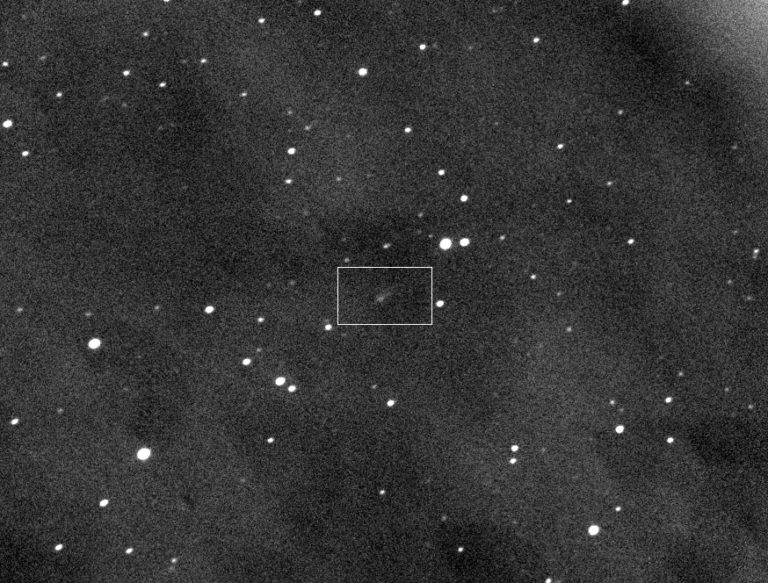Karl Battams • Aug 13, 2013
Comet ISON lives on! (we think...)
This blog was originally posted at the Comet ISON Observing Campaign website but has been updated for posting here by the author. --ESL
Well this is rather exciting news: Comet ISON lives on! (we think...)
For several weeks now, ground-based observers have been blind to Comet ISON as our local star was sitting directly between us and the comet. We knew this was a temporary problem, and we expected that by the end of August, ground-based observers would begin to detect Comet ISON, so long as it hadn't fizzled out during that time. So now I am delighted to share two pieces of good news: first, that ISON is still alive and well, and secondly that it has been recovered a couple of weeks earlier than I would have expected!

The above image was recorded by amateur astronomer Bruce Gary using his 11-inch telescope at Hereford Arizona Observatory, and shows what appears to be a comet, situated exactly where Comet ISON is currently predicted to be! Yes, the comet looks faint in this image, but it was only a few degrees above the horizon when this image was recorded, and the images are being somewhat washed out by twilight. It's actually a remarkable feat to have imaged ISON this close to the Sun, and Bruce is to be applauded for that! It should be noted that these images are awaiting confirmation, and indeed Bruce himself states very clearly: "[a] final claim that this is Comet ISON should be based on another clear morning's observations showing the expected motion". This is a critical point: while this certainly looks like a comet, does it move the way we would expect it to be moving? If it does, then that's another valuable piece of evidence that we are indeed looking at what we hope it is.
If it looks like a duck, and quacks like a duck...

Thankfully, Bruce is clearly an experienced and diligent observer, and has already taken it upon himself to begin a motion analysis to answer this very question! In the plot above (which is only a quickly-made preliminary analysis, hence the question-marks on the axes), Bruce has plotted the right ascension [blue] and declination [red] of his observations versus time. When he draws a line through those red and blue data points, he then calculates the slope of that line to tell him the rate of motion (i.e. distance divided by time). His results are remarkably close to the rate of motion we would predict for Comet ISON, lending significant weight to the likelihood of his observations indeed being that of Comet ISON. The only “outlier” in his above observations is the red data-point in the lower-right of the plot, where Bruce has indicated that the sky was getting brighter and thus the error (uncertainty) in his observation is much larger. Thus it is perfectly valid and reasonable that he should give less weight to that data point and fit his red line to the four darker-sky observations.
Another way in which we can be pretty confident that we do not have a case of mistaken identity here is by looking at the tail of the comet. The below image is a median of Bruce’s observations aligned with the ISON-candidate centered, hence the stars are somewhat elongated. Clearly we see what looks like a central condensation (nucleus?), surrounded by a diffuse cloud (coma?) that seems to extend off in one direction in particular (tail?). We know that a comet’s tail is going to be pointing away from the Sun, so we ask the question of where the Sun is relative to this image. The answer: off the lower-left corner.
Finally, we can look at the brightness of the object and see if it’s at least roughly what we’d expect from Comet ISON. Keep in mind here that ISON is a wild-card, so we can not be certain what its brightness is going to do, but when we last saw it in May/June, it had a visual magnitude of around 15. Based on various models, we would estimate that ISON now should be anywhere from about mag 13 to mag 15. Bruce estimates the object in the center of these images to be approximately 14.30 +/- 0.23 –right in the middle of where we would expect ISON to be.

When put together, this is all very compelling evidence that Bruce has indeed recovered Comet ISON. We are going to need several more observations like this from different observers around the world before we are going to be willing to make an updated prediction on ISON's future behavior, including how bright it is going to get and whether it will reach or survive perihelion, so please don't leap on us for a week or two about that! Just stay tuned to the Comet ISON Observing Campaign (CIOC) website and you'll be among the first to know!
The Time is Now.
As a Planetary Defender, you’re part of our mission to decrease the risk of Earth being hit by an asteroid or comet.
Donate Today

 Explore Worlds
Explore Worlds Find Life
Find Life Defend Earth
Defend Earth

